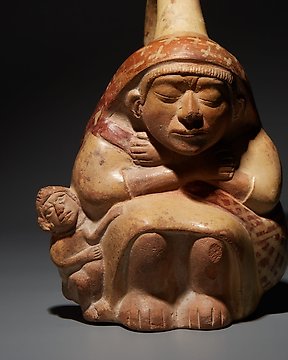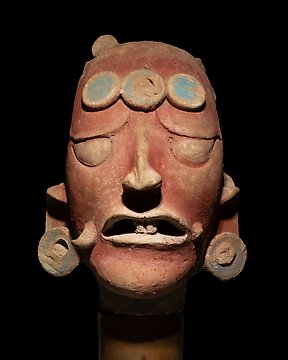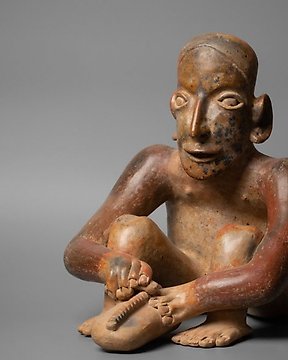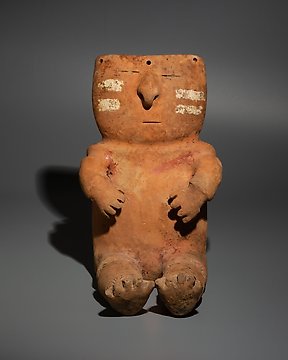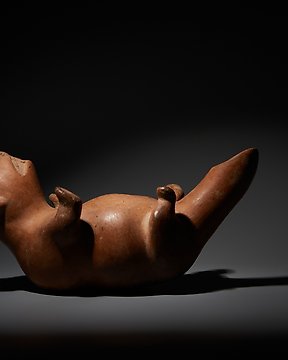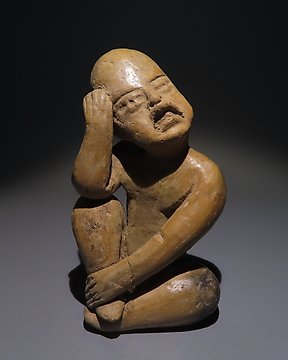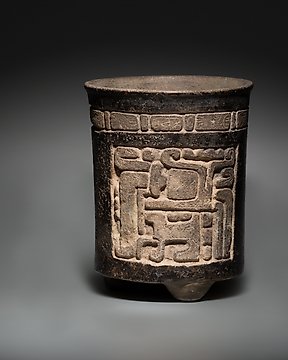super 💯💯💯💯💯
Visualizza traduzioneMoche, Perù Terracotta Huaco figurativo con scena erotica. 300-600 d.C. 21 centimetri di altezza. Licenza di porto
N. 85154581
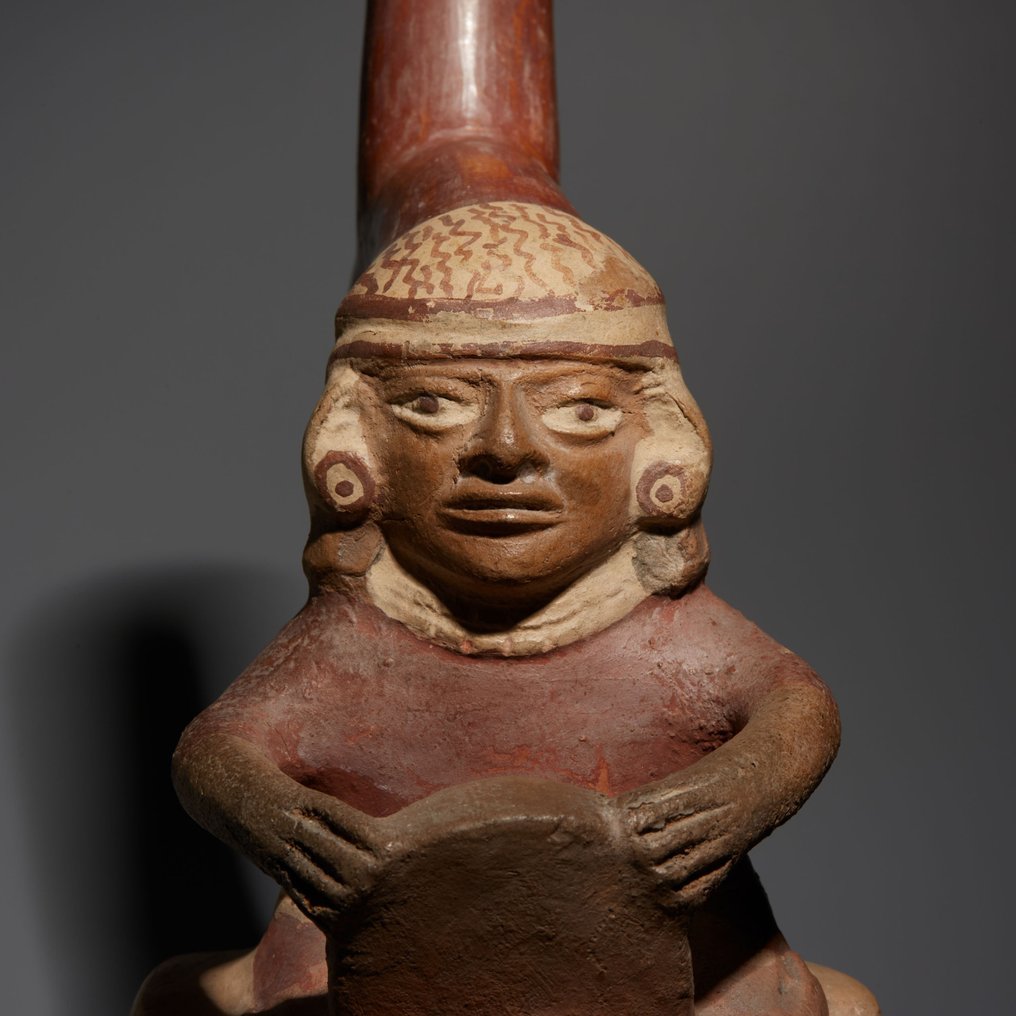


Figurative huaco with erotic scene.
CULTURE: Moche, Perú
PERIOD: 300-600 AD.
MATERIAL: Terracotta
DIMENSIONS: Height 21 cm
CONDITION: Good condition. It has slight wear on the right hand.
PROVENANCE:
- Kemper Collection, Switzerland. Donated to the "Museum of Islamic Art", Jerusalem, during the 1970s. Acquired by Yossef Maiman in 1991.
The Kepmer collection was created between the years 1940 and 1980. The items that were not donated to the "Museum of Islamic Art" were sold at Christie's Amsterdam on April 11, 1995.
DOCUMENTATION: Spanish Import license included.
DESCRIPTION:
The Moche culture inhabited the coast of present-day northern Peru, concentrating in the valleys of Lambayeque, Chicama, Moche and Virú. This desert region is crossed by several rivers that flow down into the Pacific Ocean, where marine resources are plentiful.
The Moche produced fine ceramic, textile and precious metal pieces. Their characteristic style can be seen in a wide range of goods such as fire-engraved gourds, wall murals, featherwork art, body painting and tattoos. Their ceramic decoration displays a level of skill that has rarely been surpassed, and included such techniques as incision, bas-relief with stamps, and painting on smooth surfaces. Many were made in state-run workshops that mass-produced pieces from molds. Their ceramics came in a variety of forms and decorative styles and displayed myths and ritual motifs as well. Notable among these earthenware forms were the so-called “portrait bottles”, bottles molded with the face of a well-known Moche figure. These highly detailed facial portraits reflect the Moche’s own use of face paint and/or tattoos, as well as elaborate headdresses. This portrait-making expertise can also be observed in everyday scenes and erotic representations, as well as in figures of individuals that were hunch backed, blind, or suffered from other disorders. They were skillful metalworkers, using gold, copper and silver to make ear ornaments, nose rings, bracelets, necklace beads, tweezers and a variety of tools. Especially notable is the tumi or ceremonial knife that was usually only carried by Moche officials.
Many of the motifs adorning early Moche ceramics were derived from the Recuay culture. These two peoples were certainly in contact, as all of the irrigation waters the Moche used in their valleys flowed down from Recuay territory. In the early years, the Moche also had contact with groups of the Salinar and Gallinazo cultures. It is very likely that the Moche disappeared when they were overtaken by the Wari Empire, but their civilization also suffered from long periods of flooding by the El Niño phenomenon, which would have destroyed their farming infrastructure and could have helped precipitate their collapse. The final stage of the Moche culture displays features that would later appear in the Chimú culture.
Notes:
The seller guarantees that he acquired this piece according to all national and international laws related to the ownership of cultural property. Provenance statement seen by Catawiki.
The seller will take care that any necessary permits, like an export license will be arranged, he will inform the buyer about the status of it if this takes more than a few days.
The piece includes authenticity certificate.
The piece includes Spanish Export License.
Il venditore si racconta
Figurative huaco with erotic scene.
CULTURE: Moche, Perú
PERIOD: 300-600 AD.
MATERIAL: Terracotta
DIMENSIONS: Height 21 cm
CONDITION: Good condition. It has slight wear on the right hand.
PROVENANCE:
- Kemper Collection, Switzerland. Donated to the "Museum of Islamic Art", Jerusalem, during the 1970s. Acquired by Yossef Maiman in 1991.
The Kepmer collection was created between the years 1940 and 1980. The items that were not donated to the "Museum of Islamic Art" were sold at Christie's Amsterdam on April 11, 1995.
DOCUMENTATION: Spanish Import license included.
DESCRIPTION:
The Moche culture inhabited the coast of present-day northern Peru, concentrating in the valleys of Lambayeque, Chicama, Moche and Virú. This desert region is crossed by several rivers that flow down into the Pacific Ocean, where marine resources are plentiful.
The Moche produced fine ceramic, textile and precious metal pieces. Their characteristic style can be seen in a wide range of goods such as fire-engraved gourds, wall murals, featherwork art, body painting and tattoos. Their ceramic decoration displays a level of skill that has rarely been surpassed, and included such techniques as incision, bas-relief with stamps, and painting on smooth surfaces. Many were made in state-run workshops that mass-produced pieces from molds. Their ceramics came in a variety of forms and decorative styles and displayed myths and ritual motifs as well. Notable among these earthenware forms were the so-called “portrait bottles”, bottles molded with the face of a well-known Moche figure. These highly detailed facial portraits reflect the Moche’s own use of face paint and/or tattoos, as well as elaborate headdresses. This portrait-making expertise can also be observed in everyday scenes and erotic representations, as well as in figures of individuals that were hunch backed, blind, or suffered from other disorders. They were skillful metalworkers, using gold, copper and silver to make ear ornaments, nose rings, bracelets, necklace beads, tweezers and a variety of tools. Especially notable is the tumi or ceremonial knife that was usually only carried by Moche officials.
Many of the motifs adorning early Moche ceramics were derived from the Recuay culture. These two peoples were certainly in contact, as all of the irrigation waters the Moche used in their valleys flowed down from Recuay territory. In the early years, the Moche also had contact with groups of the Salinar and Gallinazo cultures. It is very likely that the Moche disappeared when they were overtaken by the Wari Empire, but their civilization also suffered from long periods of flooding by the El Niño phenomenon, which would have destroyed their farming infrastructure and could have helped precipitate their collapse. The final stage of the Moche culture displays features that would later appear in the Chimú culture.
Notes:
The seller guarantees that he acquired this piece according to all national and international laws related to the ownership of cultural property. Provenance statement seen by Catawiki.
The seller will take care that any necessary permits, like an export license will be arranged, he will inform the buyer about the status of it if this takes more than a few days.
The piece includes authenticity certificate.
The piece includes Spanish Export License.
Il venditore si racconta
- 746
- 7
- 0
Il pezzo è arrivato in condizioni perfette il pacco era protetto alla perfezione
Visualizza traduzioneBuenos días, señor. ¡Gracias por las precauciones de embalaje Tip / Top! Muy contento con mi compra. ¡Gracias!
Visualizza traduzionePerfecto! :)
Visualizza traduzioneWunderbares Stück. Alles wie beschrieben. Hervorragender Kontakt.
Visualizza traduzioneExtremely rapid courrier service from Barcelona to Flanders, picture was nicely and carefully packaged. Muchas gracias!
Visualizza traduzioneVery fine specimen! Thanks.
Visualizza traduzionegoede foto's, goede omschrijving, goed verpakt en snel verzonden.
Visualizza traduzionemolto bello tutto ok
Visualizza traduzionePezzo come da descrizione, davvero notevole. Venditore molto consigliato in quanto gentile e disponibile. spedizione molto veloce. Ottimo!
Visualizza traduzioneVenditore davvero ottimo e gentile. Merce come da descrizione, spedizione veloce. Ottimo l'avere certificato di autenticità.
Visualizza traduzioneUn 100 como empresa un 100 como envío . Empresa muy especial con mucha exquisitez en todos los productos y en personal . Muchas gracias
Visualizza traduzioneAll well! Thanks.
Visualizza traduzioneVery nice and fine cut little jewel! Well packed too! Thanks!
Visualizza traduzionenice piece and very fast shipping!
Visualizza traduzioneEs una maravilla de moneda, donde se le nota los pasos de los años y me encanta. Servido muy rápido y bien empaquetado. Con su certificación. Qué más se puede pedir?
Visualizza traduzioneSnelle en correcte levering, alleen was de verpakking voor het schilderij niet stevig genoeg.
Visualizza traduzioneHerzlichen Dank!
Visualizza traduzioneAll OK and with very fast shipping.
Visualizza traduzionePrachtig schilderij. Zo blij mee. Zeer nette verkoper en zeer snelle levering.
Visualizza traduzioneperfect ! very fast and high quality delivery !
Visualizza traduzioneAll well! Thanks.
Visualizza traduzioneVendeur très professionnel, top +++×
Visualizza traduzionePhotos trop contrastées pour bien percevoir les défauts, mais ces défauts étaient visibles pour autant. Le "Bon état" est trompeur. Sinon, envoi rapide et correctement emballé. Frais de port exagérés.
Visualizza traduzioneDisclaimer
Il venditore garantisce e può provare che l’oggetto è stato ottenuto legalmente. Il venditore è stato informato da Catawiki di dover fornire la documentazione richiesta dalle leggi e dai regolamenti del suo Paese di residenza. Il venditore garantisce ed è autorizzato a vendere/esportare questo oggetto. Il venditore fornirà all’acquirente tutte le informazioni di provenienza note sull’oggetto. Il venditore garantisce che tutti i permessi necessari sono/saranno predisposti. Il venditore informerà immediatamente l’acquirente di eventuali ritardi nel rilascio di tali permessi.
Il venditore garantisce e può provare che l’oggetto è stato ottenuto legalmente. Il venditore è stato informato da Catawiki di dover fornire la documentazione richiesta dalle leggi e dai regolamenti del suo Paese di residenza. Il venditore garantisce ed è autorizzato a vendere/esportare questo oggetto. Il venditore fornirà all’acquirente tutte le informazioni di provenienza note sull’oggetto. Il venditore garantisce che tutti i permessi necessari sono/saranno predisposti. Il venditore informerà immediatamente l’acquirente di eventuali ritardi nel rilascio di tali permessi.

